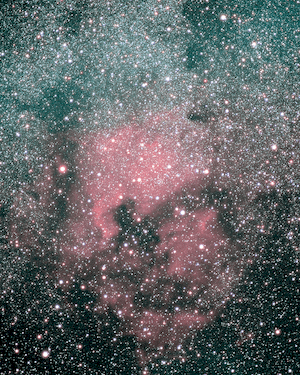North America nebula facts for kids
The North America Nebula is a giant, glowing cloud of gas and dust far out in space. It's called this because, from Earth, it looks a lot like the continent of North America! This amazing space cloud is also known by its science names, NGC 7000 or Caldwell 20. It is about 1,600 light-years away from our Earth.
Contents
The North America Nebula
What is a Nebula?
A nebula is a huge cloud of gas and dust in space. Some nebulae are places where new stars are born. Others are the remains of stars that have exploded. The North America Nebula is a special type called an emission nebula. This means it glows brightly because the gas inside it is heated up by nearby hot, young stars. These stars make the gas light up, like a giant neon sign in space.
Where is the North America Nebula?
This glowing cloud is found in the Cygnus constellation. Cygnus is also known as "The Swan" because its stars form the shape of a swan flying through the sky. You can find the Cygnus constellation in the northern sky during summer and autumn. The North America Nebula is a neighbor to another famous nebula, the Pelican Nebula.
How Far is a Light-Year?
When we talk about distances in space, we often use "light-years." A light-year is the distance light travels in one whole year. Light travels incredibly fast, about 300,000 kilometers (186,000 miles) every second! So, 1,600 light-years means the light we see from the North America Nebula today started its journey 1,600 years ago. It has been traveling through space all that time to reach our eyes.
What Makes it Glow?
The North America Nebula glows because of a very hot, bright star. This star is called Deneb, which is one of the brightest stars in the Cygnus constellation. Deneb's powerful ultraviolet light makes the hydrogen gas in the nebula glow red. Other gases, like oxygen, can glow blue or green. This mix of glowing gases creates the beautiful colors we see in nebulae.
How Can We See It?
The North America Nebula is very large, covering an area of sky about four times the size of the full Moon. However, it is also quite dim. This means it can be hard to see with just your eyes, especially if there is a lot of light pollution. To see it best, you would need a good pair of binoculars or a small telescope. Even better, long-exposure photographs taken by astronomers show its amazing details and colors.


